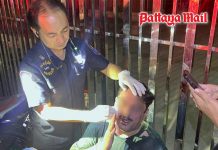
In 1923 the Siamese Government invited Bradbury Wilkinson & Company, Waterlow & Sons, Thomas de la Rue & Company Limited, and American Bank Note Company to submit bids to produce the Second Series Siamese Banknotes. In the letter sent out on August 14th the Siamese Legation informed them that the first order would be for 15 ½ million banknotes of six denominations.
The invited companies had to be prepared to send a representative to Bangkok at their own expense and without any commitment. This was to inspect the design and to receive full particulars of the requirements. The representatives were to arrive in Bangkok no later than October 15th.
Thomas de la Rue & Company Limited London (TdlR) had been producing banknotes for Siam since 1902. In this connection, TdlR had already been informed in June1921 that a new series was planned, when a representative of TdlR had the pleasure of calling at His Majesty’s Ministry of Finance in Bangkok. They therefore had an advantage to prepare bids producing the Second Series Banknotes. On 23rd December 1921 TdlR sent a letter to the Minister of Finance that designs would be prepared in Siam to be submitted to TdlR within a short time for quotations.
In the same letter, TdlR introduced to the Minister of Finance a process of note printing which they strongly recommended. They had recently installed the photogravure process for note printing in their most modern plant. A specimen note would be submitted to the Minister in the near future for his consideration. The British Government had already adopted the process.
It was discussed whether TdlR would use the photogravure process to produce the artwork or whether a different technique would be used. Paper Money Guaranty (PMG) refers to some of the artwork as archival photograph while TdlR referred to it as photogravure in one of their correspondences. The book “The Highest Perfection, A History of De La Rue” by Peter Pugh refers to when postal orders would be used as currency at the beginning of the First World War in 1914.
TdlR secured the contract to produce the 10s Treasure Note. At the same time, TdlR designed a £1 bank note. In spite of this, the contract for printing the £1 banknote was given to Waterlow Brothers and Leighton. Waterlow Sons and TdlR worked together to get a second contract for printing the treasure notes. Neither of them won. The Waterlows Brothers and Leighton won the contract with their new and cheaper process called “photogravure”. It is therefore likely that after TdlR got it installed they would be using the photogravure process.
Towards the end of 1022, TdlR accredited a representative, Mr. Bernhard Clement Westall, to go to Bangkok to meet with the Ministry of Finance to discuss the new series of banknotes. B. C. Westall returned to London aboard the S.S. “Kalyan” Tuesday, 1st January 1923, bringing sketches of the new issue of banknotes, Second Series. The Ministry of Finance in Bangkok wanted TdlR to send the finished artwork with the least possible delay. TdlR had put it to work and would despatch the artwork within a fortnight.
Artwork dated 29th December 1920 had the prefix V/97 and the number 12345. The One Baht had in the lower margin the letter D written with a pen. The other denominations, 5-, 10-, 20-, 100- and 1000 Baht had A, B and C written with a pen in the lower margin. These artworks were probably produced using the photogravure process as 16 different designs were produced in a fortnight.
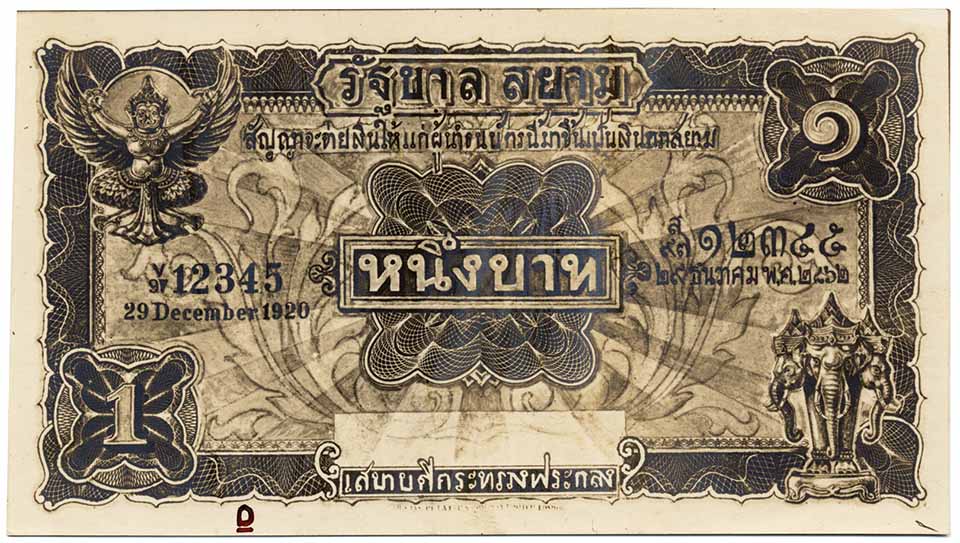
One Baht prefix V/97, number 12345 and dated 29 December 1920 with D in lower margin. Instructions were sent by the Ministry of Finance by telegram on 6th June 1924 to “Remove floral work entirely. Rays with microscopic lettering to be superimposed. Designation on lower border.” With those changes approved using signature space as artwork marked with C.
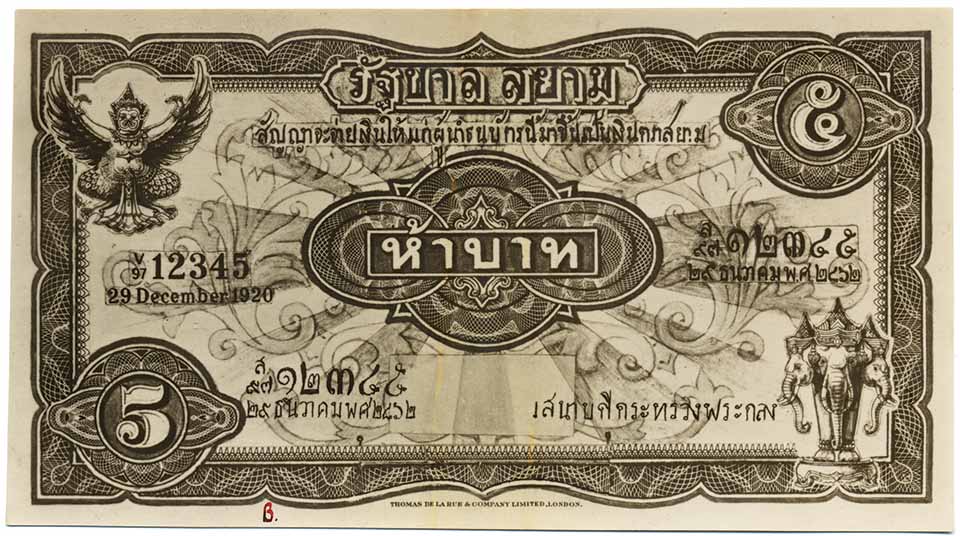
5 Baht, prefix V/97, number 12345 and dated 29 December 1920 with B written in the lower margin. English prefix, numbers and date to the left of the written denomination “FIVEBAHT”. Thai prefix, numbers and date to the right of the denomination and to the left of the space for the signature. Designation to the right of the space was for the signature of the Minister of Finance. This design was not approved.
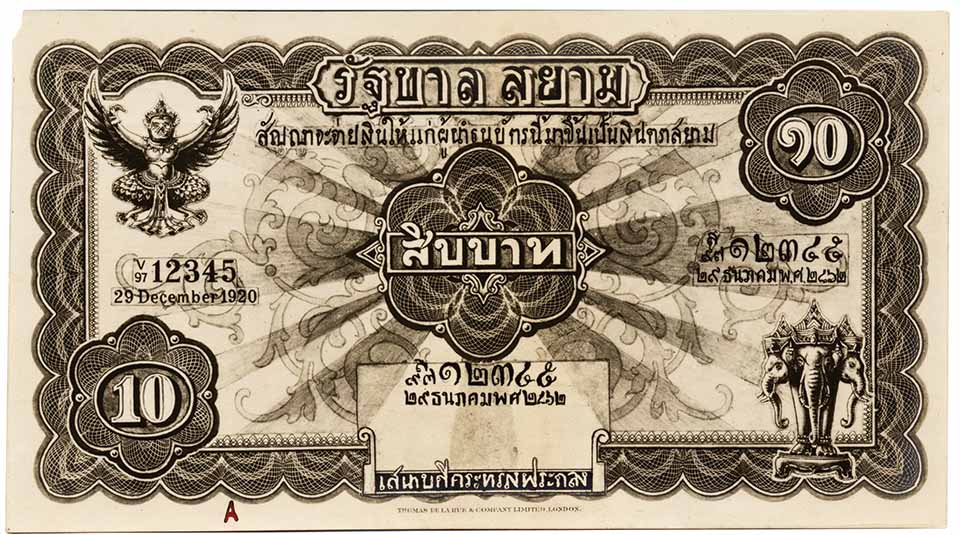
10 Baht, prefix V/97 and number 12345 with A written in lower margin. English prefix, numbers and date to the left of the written denomination “TENBAHT”. Thai prefix, numbers and date to the right of the denomination and above the space for the signature. Designation for Minister of Finance on the lower border. The Thai prefix, number and date above space for the signature to be removed. With those changes approved using signature space as in C.
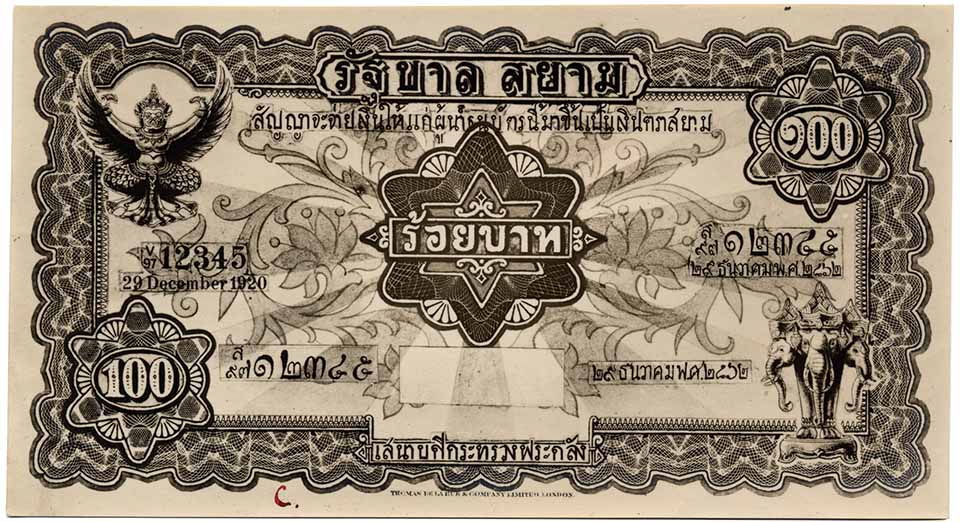
100 Baht, prefix V97, number 12345 and date 29 December 1920 with C written in lower margin. English prefix, numbers and date to the left of the written denomination “HUNDREDBAHT”. Thai prefix, numbers and date to the right of the denomination and to the left of the space for the signature. Designation to the right of the space for the signature of the Minister of Finance. Designation on lower border. This design was not approved. The space for signature and the designation was approved for all notes from designs marked C.
The companies’ representatives were given the specifications and designs on their arrival to Thailand. TdlR had the sketches for the designs and had already prepared the artwork. Another producer, Bradbury Wilkinson & Company, had prepared artwork for two banknotes, a 1- and 100 Tical/Baht. Some of the text used was from the First Series banknotes. On the reverse, the “Coat of Arms” was in a middle circle. Above in Thai, “Government of Siam”. To the left of the circle, a big 1 and to the right of the circle a Thai 1. Below the 1 to the left “ONE TICAL”. Below the Thai 1 to the right in Thai “ONE BAHT”. Bradbury Wilkinson & Company was not aware that King Vajiravudh, Rama VI, had not given His Royal Permission to have his portrait on banknotes.
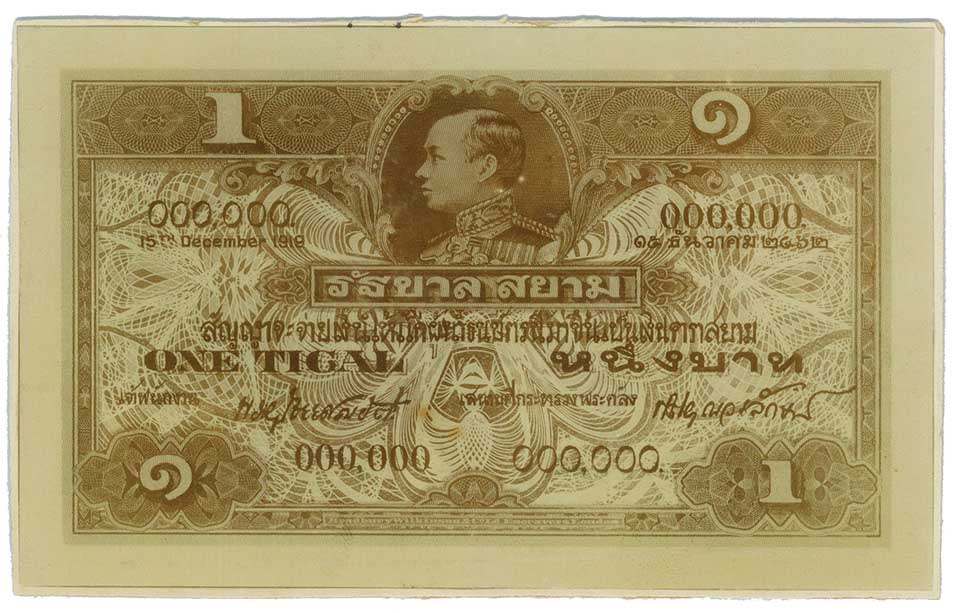
On the obverse of the One Tical/Baht dated 15th December 1919, there is the number 000,000 with a portrait of King Vajiravudh, Rama VI. Above the Thai text “RATTABAN SIAM”, translated as “Government of Siam”. Number and date in English to left of portrait, Thai date to right of portrait. Under “Government of Siam” the Thai text translated to English “Promise to pay the bearer on demand in Siamese currency.” Below this to the left “ONE BAHT” and to left Thai “ONE BAHT”. The designation of the Authorized Bank Official to the left, the signature of Phraya Chaiyos Sombat above the lower left number. To the right of the signature of the Authorized Bank Official, the designation of the Minister of Royal Finance, to the right the signature of H.H. Prince Kitiyakara partly above the lower right number.

The reverse has the “Coat of Arms” in a middle circle. Above in Thai “Government of Siam”. To the left of the circle a big 1 and to the right of the circle a Thai 1. Below the 1 to the left “ONE TICAL”. Below the Thai 1 to the right in Thai “ONE BAHT”
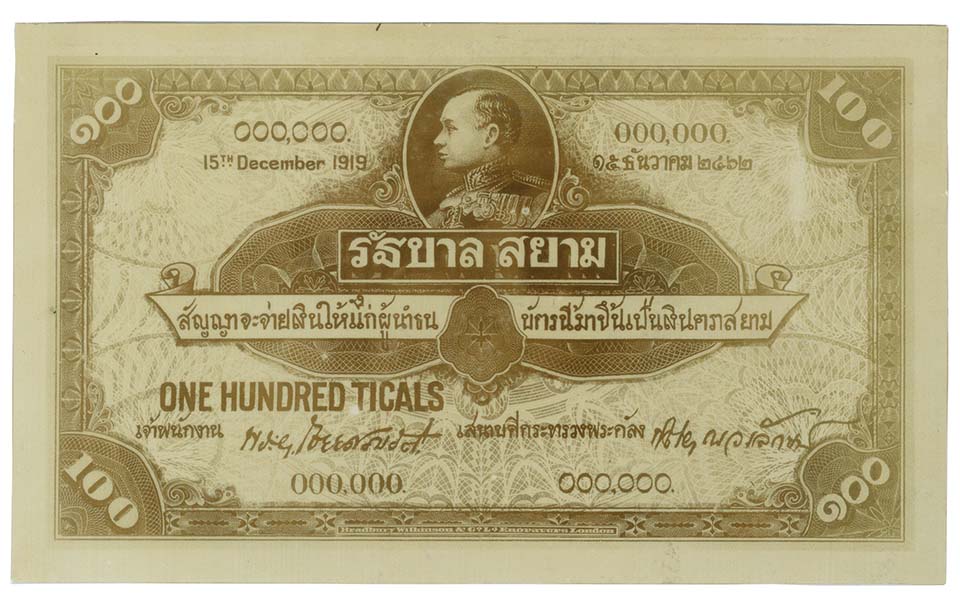
Obverse 100 Tical/Baht dated 15th December 1919, number 000,000. Portrait of King Vajiravudh, Rama VI, above the Thai text “RATTABAN SIAM”, translated “Government of Siam”. Number and date in English to left of portrait, Thai date to the right of the portrait. Under “Government of Siam” the Thai text translated to English “Promise to pay the bearer on demand in Siamese currency”. Below this to the left “100 BAHT”. The designation of the Authorized Bank Official to the left, the signature of Phraya Chaiyos Sombat above the lower left number. To the right of the signature of the Authorized Bank Official the designation of the Minister of Royal Finance, to the right the signature of H.H. Prince Kitiyakara partly above the lower right number.
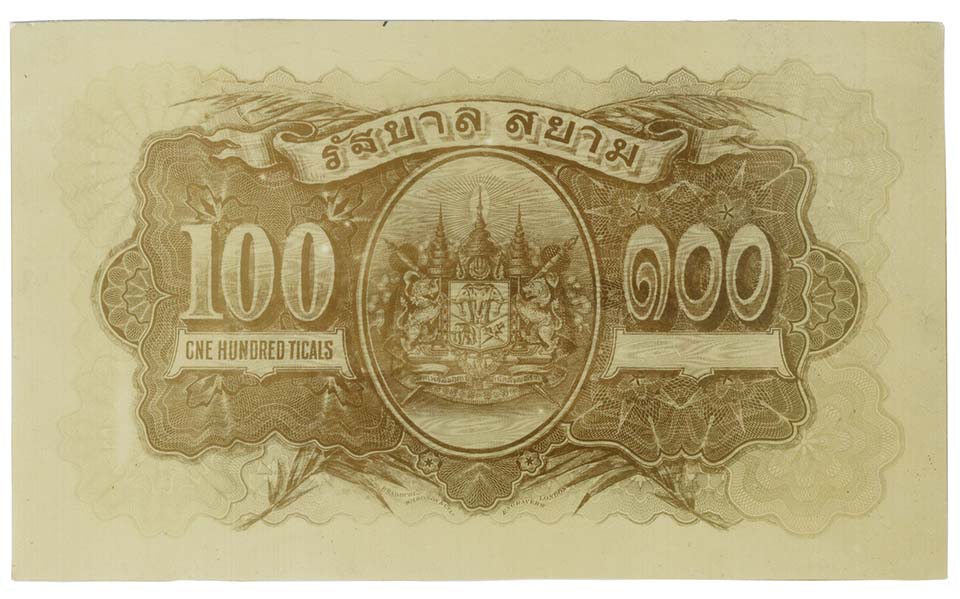
On the reverse, the “Coat of Arms” is in a middle circle. Above in Thai “Government of Siam”. To the left of the circle a big 100 and to the right of the circle a Thai 100. Below the 100 to the left is “ONE HUNDRED TICAL”.
After having seen the instructions from the Ministry of Treasure, Waterlow & Sons later presented the 10 and 20 Tical/Baht artwork. They were dated 29th December 1919, had the prefix X/12 and the number 31260. Those artworks are displayed in the Bank of Thailand Museum and also published in the book “BOT Museum’s Masterpieces.” The artwork also had the denomination in Thai and Arabic like on the First Series 5-, 10-, 20, 100- and 1000 Tical/Baht First Series. On the One Baht First Series this was omitted. Probably the specifications did not contain all the details needed.
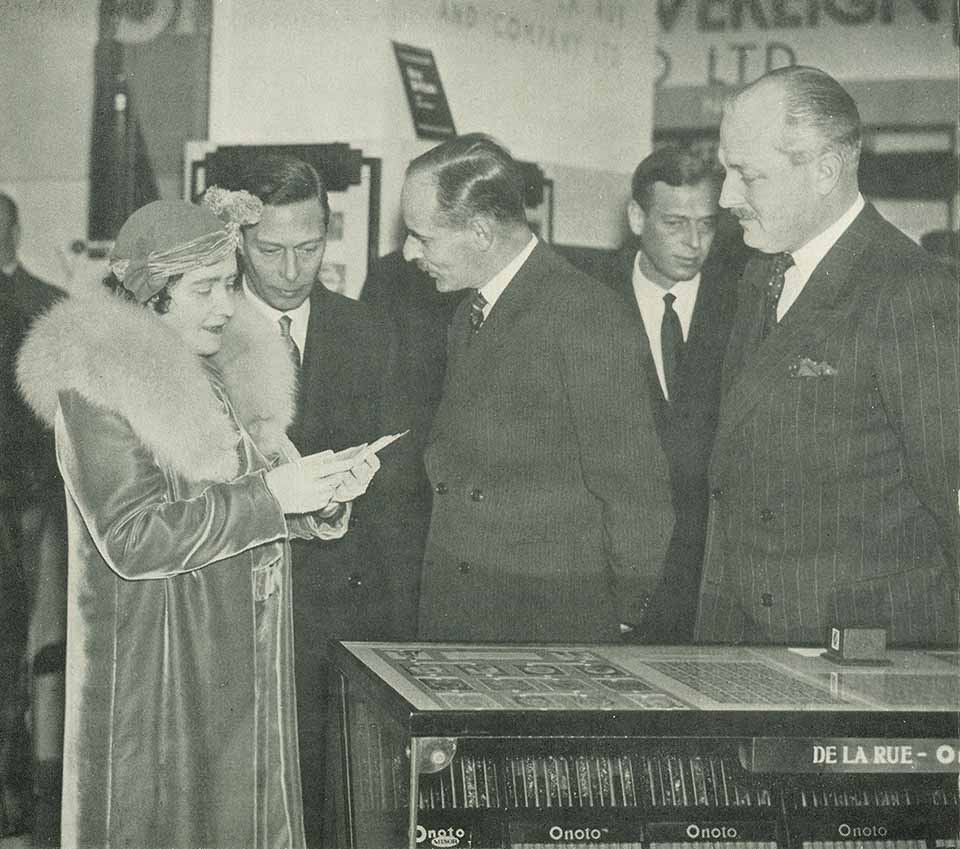
On 1st December 1923, Thomas de la Rue & Co won the bid and was assigned to print the Second Series Banknotes. The contract was signed the same day by H.H. Prince Subhayok Kasem, Minister of Finance, on behalf of His Majesty’s Government and Bernard Clement Westall, duly authorised in that behalf by Messers. Thomas de la Rue & Co.
Bernard Clement Westall left London in the middle of September 1923 for his second visit to Bangkok where he spent a considerable amount of time in negotiations. His daughter Lorna Housman described her father’s travels and negotiations in her book “The House that Thomas Built, The story of de la Rue”:
“Twenty-nine year old Bernhard Westall found himself in a four berth cabin abroad a P. and O. ship sailing to places he had only read about and never expected to see: the Suez Canal, Aden, Bombay, Colombo. Like Lamert he was the son of a parson, a particular impecunious one, the intensity of the Rev. Arthur St Ledger Westall’s belief having led him from the Church of England to the Church of Rome, and back again. As Father Westall was descended from a long line of clerics with large families and small stipends, he had little money of his own. Scholarships enabled his eldest son Bernhard to go from grammar school to Cambridge, where he read Classics like his father, with the similar intention of entering the Church. He took a wartime degree before going out with the Essex regiment to France, and later Gallipoli. He thought his foreign travels had ended there.
With fifty pounds in his pocket, which was supposed to last for three months, he disembarked at Penang, caught the weekly train from Prai on the mainland, chugged through rubber plantation and jungle, and arrived in Bangkok. There, on the banks of the Menam, the mosquitoes were so powerful that in the evenings visitors were handed a sarong in which to enshroud their legs, Westall got into his rickshaw and preceded unceremoniously to the compound of the Royal Palace were the Ministry of Finance is situated. He saw the Government‘s British adviser, who dashed any hopes by stating crisply that he had warned the Siamese dealing with De La Rue.
When Westall eventually obtained an interview with the Controller General, Phya Anaraks Kosa, news of the firm’s financial precariousness had preceded him. Why, Phya Anaraks wanted to know, should his government do business with a company, which was liable to go bankrupt at any moment? There was only one answer. Frankly, said Westall, De La Rue needed the order more than any of the other firms and could therefore be relied upon to put in a very low price. He suggested that a clause would be inserted into the contract with De La Rue, stipulating that if that the worse happened and the Company went into liquidation, the plates and paper remained the property of the Siamese Government and could be handed over to one of the other printers. Still nervous about the company’s future, Phya Anaraks was nevertheless attracted by the notion that if De La Rue were allowed to tender, everyone else had to trim their prices.
The solitary question that remained was the fact that the Siamese required copperplate printing in which De La Rue were known to be inexperienced. That problem, counted Westall, was easily disposed of; would the Government be prepared to have Waterlow, the acknowledged copperplate expert, print the new issue? ‘Of course’ answered the Controller General. “Well then,” he re-joined, “a fortiori you should be satisfied with De La Rue. Perhaps you are unaware that leading personal in Waterlow recently transferred to De La Rue.” Agreeably surprised, the Controller General began to soften and granted Westall permission to tender.
Although the first Siamese hurdle was crossed, others lay ahead. When Westall was handed a copy of the specifications an immediate difficulty beset him – he had no idea what price he should offer. De La Rue affairs were still so haphazard that Bunhill Row possessed no estimating department. He spent an anxious night at his hot hotel bedroom trying to calculate the potential output of the unfinished rotary copperplate machine, plus overheads, the percentage of wastage and the cost of subsequent operations. That done he borrowed the hotel typewriter, with one finger tapped out calculations, and took his offer round to Phya Anaraks Kosa the next morning.
It was a week before anything happened. Idling meanwhile over the page of Bangkok Times, Westall read that the Siamese Government was experiencing some difficulty with forged customs certificates. He presented himself at the Customs office. The junior official he saw was a contemporary of his at Cambridge, who was called Prince Viwat. In the city of many princes, he was destined to become a world figure, not only Minister of Finance and authority at the World Bank, but also the statesman who headed his country’s deputation at the Kandy peace treaty conference after World War II.
Prince Viwat was struck by Westall’s idea of introducing a security into customs forms. He persuaded his chief to order some from De La Rue. The little factory in Walthamstow profited too. Insulators were about the only product it was capable of making, and Westall sold a quantity to the Siamese Post office for telephone poles.
During the enforced wait, he was getting acutely short of money. Luckily for him he was an exceptionally good bridge player and was able to supplement his finances. Phya Anaraks eventually lifted his spirits by sending for him again. Only one thing prevented him from giving De La Rue the contract, he confided; how would he not have De La Rue, having quoted a low price, be tempted to put it up after completing the first order? “By multiplying the quantities of the notes to be ordered by five, and stipulating delivery over five years,” suggested Westall. Phya Anaraks capitulated and gave De La Rue a five year contract.
Westall’s nocturnal mental arithmetic proved to be accurate. His estimated figure was within a couple of hundred pounds of the actual cost of the ฃ125,000 order. To Mr Lemert’s amazement, the Siamese visit had been a resounding success. As a result of its Portals, the papermakers received a letter from their agents which began, “De La Rue have a Banknote enquiry for us at last…” The sentiment was shared to a heartfelt degree by everyone at Bunhill Row.”
In 1924, TdlR produced artwork for 20- and 100 Baht Banknotes dated 1st July 1926, with prefix B/78 and number 98199. They both originally had the portrait of King Vajiravudh, Rama VI. Probably TdlR produced the 20-and 100 Baht as an alternative for the Royal Ploughing Ceremony Banknotes, Second Series. The portrait on the notes were later replaced with the portrait of King Prajadhipok, Rama VII, which would be used for Third Series.

20 Baht, 1st July 1926, red serial number B/78 98199. Hand executed obverse artwork for the proposed issue, green with orange background, King Prajadhipok, Rama VII, at left, Mae Ping River depicting traditional Mae Pa or scorpion tail boat and a scene of a river community at the centre, Garuda at top left. On the upper margin “1924” is written with a pen.
This artwork was produced by Thomas de la Rue & Company Limited London for the Second Series and had a portrait of King Vajiravudh, Rama VI, but the King did not want to have his portrait on a banknote. For the Third Series, the artwork was again presented. The portrait of Rama VI was replaced with a portrait of Rama VII. In the lower margin written with a pencil “Green plate printing (White Line – vignette-portrait-ornament-caractere.”
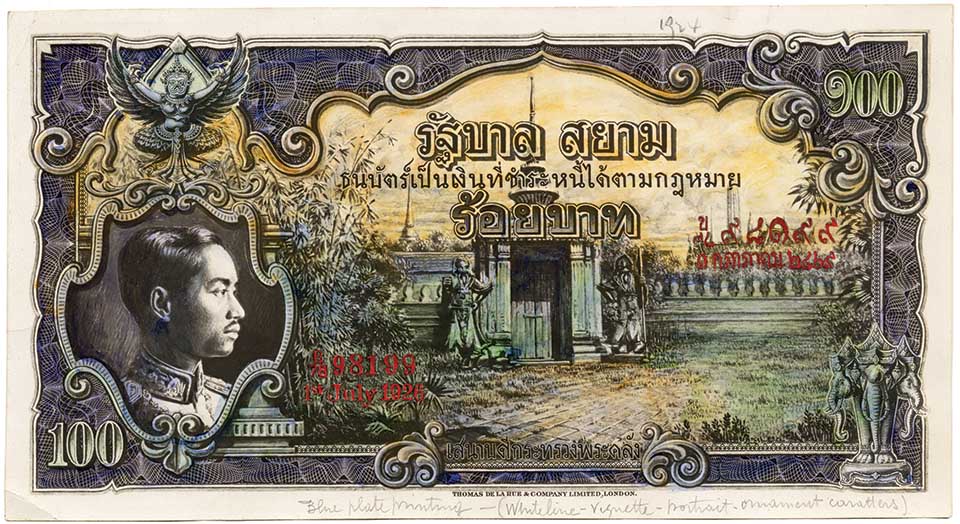
The 100 Baht, 1st July 1926, red serial number B/78 98199. Hand executed obverse artwork for proposed issue, green with orange background, portrait of King Prajadhipok, Rama VII, at left, gate of Wat Poh at the centre, Garuda on top left. On the upper margin “1924” is written with a pen. This artwork was produced by Thomas de la Rue & Company Limited London for the Second Series and had a portrait of King Vajiravudh, Rama VI, but the King did not want to have his portrait on a banknote. For the Third Series the artwork was again presented. The portrait of Rama VI was replaced with a portrait of Rama VII. In the lower margin written with pencil are the words “Blue print printing – (White line – vignette – portrait- ornament caractere.”
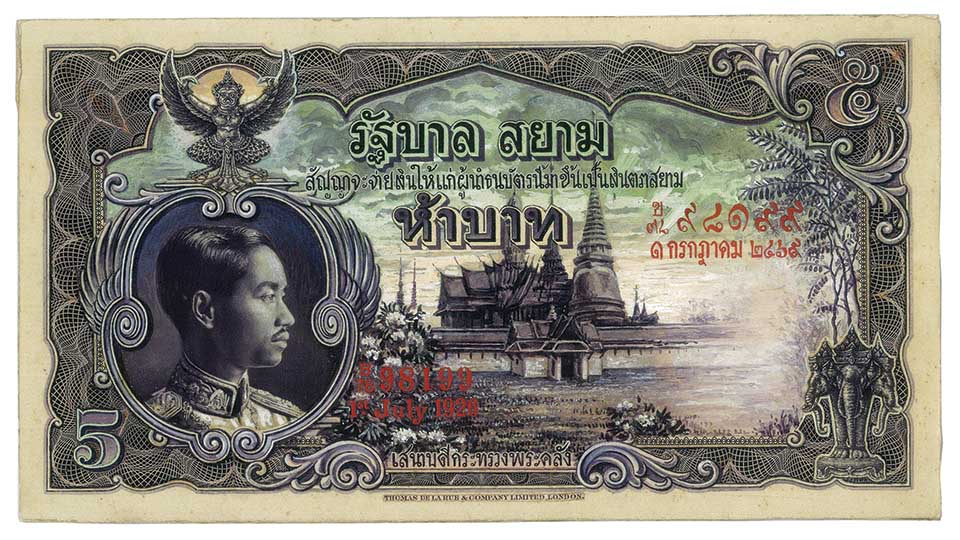
The 5 Baht 1st July 1926, red serial number B/78 98199. Hand executed obverse artwork for the proposed issue, violet and multi-coloured. An image of King Prajadhipok, Rama VII, at left, Wat Phra Sriatanasasadaram or the Temple of the Emerald Buddha at the centre, Garuda on top left. Produced by Thomas de la Rue & Company Limited. London References Pick -, TB -. This was probably produced later than the 20- and 100 Baht with the same date. A 10 Baht produced in the same manor was sold in the Spink, Singapore Auction on 4 July 2009 for S$70,000. In the low centre of the 10 Baht is “Water Buffalo and Farmer with Plough.”
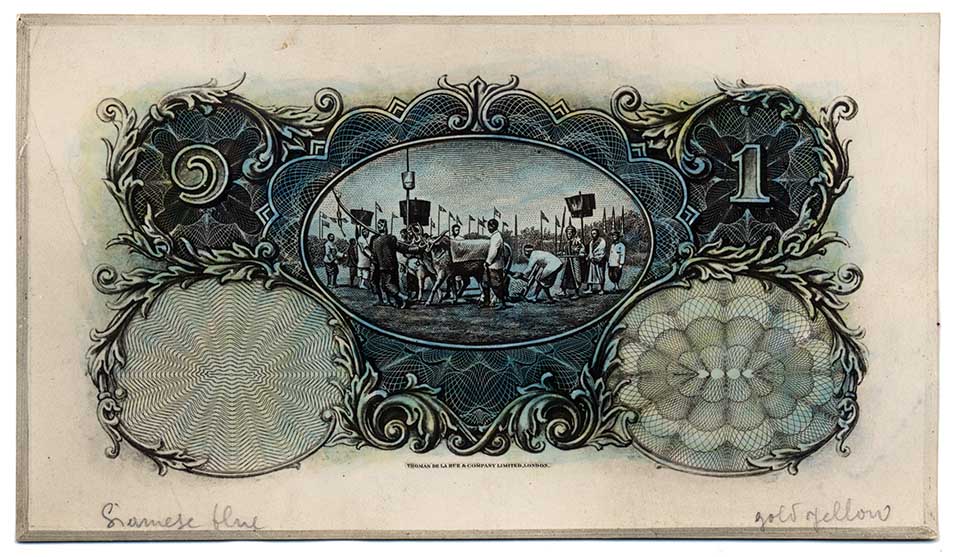
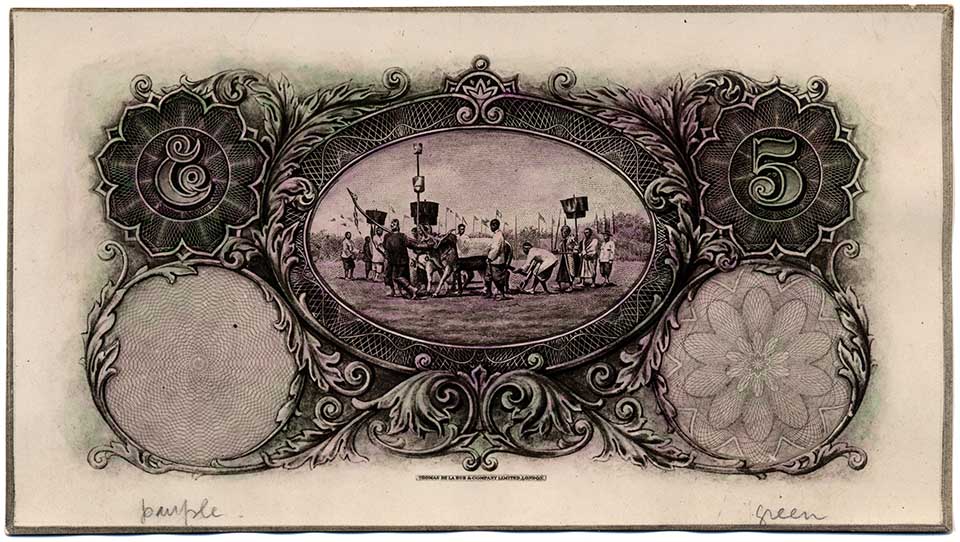
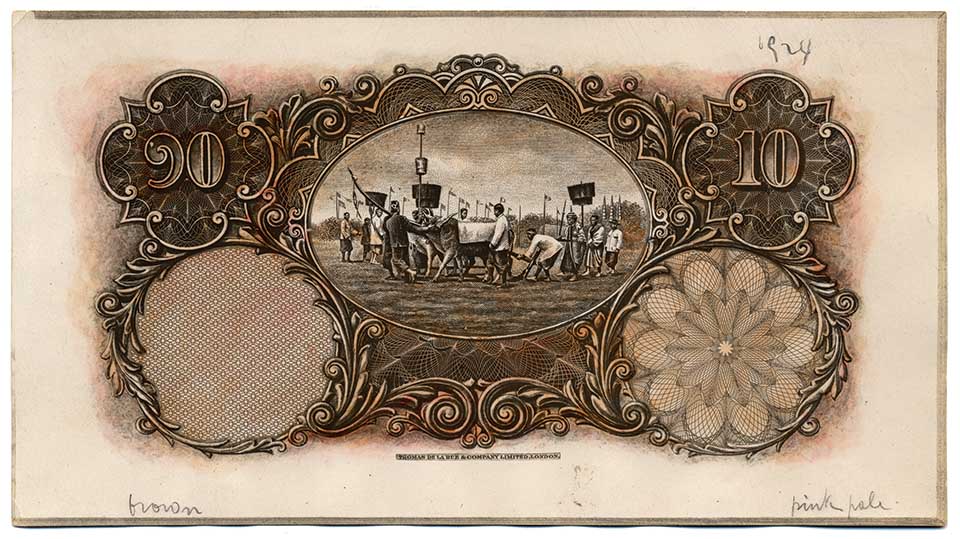


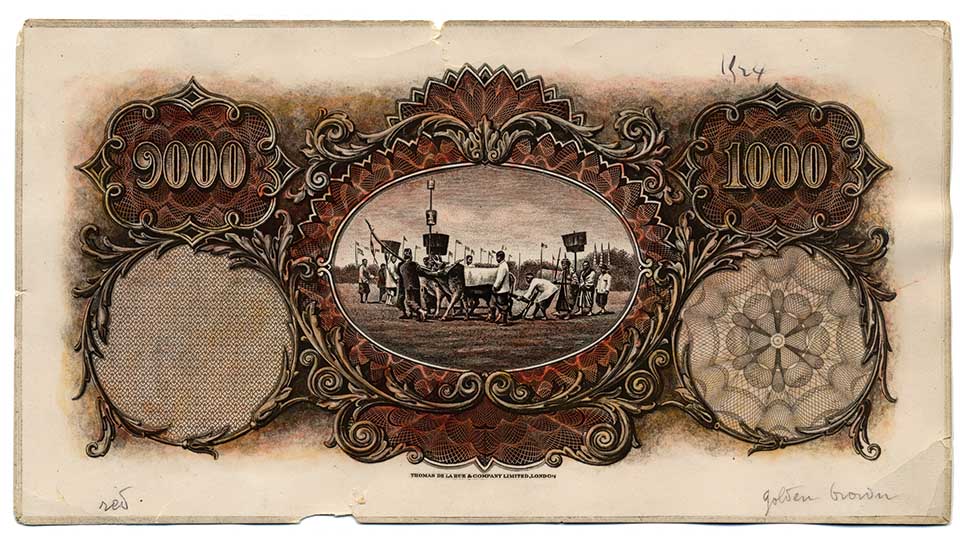
In 1924 TdlR produced artwork for the reverse of the six denominations in colour. All have a picture in the upper middle picture of the Royal Ploughing Ceremony. I am not sure what technique was used to produce these. In lower left corner of the one Baht banknote written in pencil are the words “Siamese blue” and in lower right corner “gold yellow.” The 5 Baht has the pencil written words “purple” in lower left corner and “green” in lower right corner.
The 10 Baht has the pencil written the date “1924” close to upper right corner and in the lower left corner “brown” and “pink pale” in the lower right corner.
The 20 Baht has “green” written with a pencil in lower left corner and in lower right corner “gray purplish.”
The 100 Baht has “1924” written with a pencil close to the upper right corner, in the lower left corner “100 tical blue” and in the lower right corner “olive green.” The 1000 Baht has “1924” written with a pencil close to upper right corner, in the lower left corner “red” and in the lower right corner “golden brown.” This design was not approved. The circulated banknotes had a different design.
In 1924 TdlR produced a hand executed artwork for all the denominations of new banknotes, 1-, 5-, 10-, 20-, 100- and 1000 Baht. The Bank of Thailand museum has all the denominations. They are presented in the book “BOT Museum’s Masterpieces.”
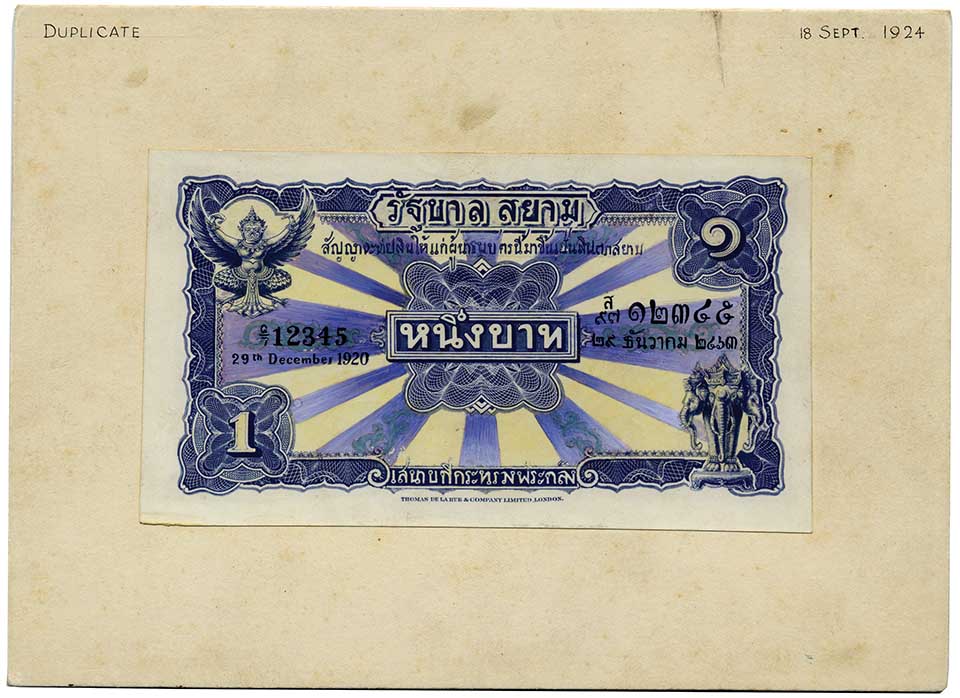
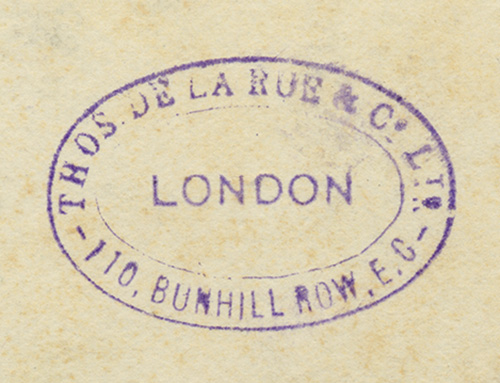
One Baht dated 29th December 1920, prefix G/7, hand executed blue artwork with twelve rays on the obverse. Mounted on cardboard the words “DUPLICATE” are written with a pen on the upper left corner. The words “18 SEPT 1924” are written with a pen on the upper left corner. On the back of the cardboard an oval rubber-stamp “THOS. DE LA RUE & C. L. 110 BUNHILL ROW. E.6”. In the middle of oval “LONDON.”

1000 Baht banknote dated 29th December 1920, prefix G/7, hand executed obverse red artwork with twelve rays. Mounted on cardboard. and written with a pen in the upper right corner the date “18 SEPT. 1924.” On the back of the cardboard an oval rubber-stamp “THOS. DE LA RUE & C. L. 110 BUNHILL ROW. E.6”. In middle of the oval “LONDON.”
In this segment I have presented some of the preparations undertaken when a new series of banknotes were to be produced. The Second Series Thai Banknotes were to be produced on paper with no watermark. On each of the banknotes there were three secret marks incorporated. I will write about this in my next article.
Acknowledgements:
Pratheep S. Malhotra
References:
-The archives of Thomas de la Rue & Company, Limited, London
-Bank of Thailand, “Centenary of Thai Banknotes: 1902 – 2002”
-Somchai Saeng-ngern, “Thai Banknotes Catalogue, Complete and Updated Edition”
-Lorna Houseman, “The House That Thomas Built, The Story of De La Rue”
-Illustrations of Siamese banknotes from Jan Olav Aamlid collection
Copyright ฉ 2022 All rights reserved by Jan Olav Aamlid
 |
 |
 |




